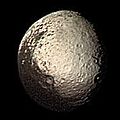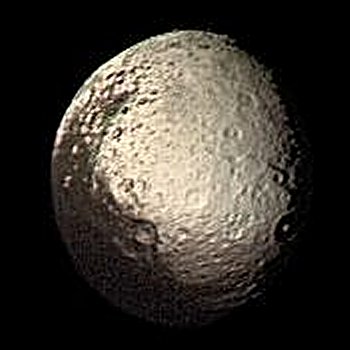Файл:Iapetus by Voyager 2 - enhanced.jpg
Iapetus_by_Voyager_2_-_enhanced.jpg (350 × 350 піксэляў, памер файла: 19 кб, тып MIME: image/jpeg)
Гісторыя файла
Націсьніце на дату/час, каб паглядзець, як тады выглядаў файл.
| Дата і час | Мініятура | Памеры | Удзельнік | Камэнтар | |
|---|---|---|---|---|---|
| цяперашняя | 20:29, 4 красавіка 2005 |  | 350 × 350 (19 кб) | Smartech~commonswiki | *'''Iapetus by Voyager 2 spacecraft, August 22, 1981''' *same as Iapetus_by_Voyager_2.jpg but focused on the mooon and feature-enhanced. *original image caption: Saturn's outermost large moon, Iapetus, has a bright, heavily cratered icy terrain and a da |
Выкарыстаньне файла
Наступная старонка выкарыстоўвае гэты файл:
Глябальнае выкарыстаньне файла
Гэты файл выкарыстоўваецца ў наступных вікі:
- Выкарыстаньне ў ar.wikipedia.org
- Выкарыстаньне ў be.wikipedia.org
- Выкарыстаньне ў ca.wikipedia.org
- Выкарыстаньне ў de.wikipedia.org
- Выкарыстаньне ў el.wikipedia.org
- Выкарыстаньне ў en.wikipedia.org
- Выкарыстаньне ў eo.wikipedia.org
- Выкарыстаньне ў es.wikipedia.org
- Выкарыстаньне ў eu.wikipedia.org
- Выкарыстаньне ў fr.wikipedia.org
- Выкарыстаньне ў gl.wikipedia.org
- Выкарыстаньне ў hr.wikipedia.org
- Выкарыстаньне ў it.wikipedia.org
- Выкарыстаньне ў ja.wikipedia.org
- Выкарыстаньне ў ko.wikipedia.org
- Выкарыстаньне ў la.wikipedia.org
- Выкарыстаньне ў lb.wikipedia.org
- Выкарыстаньне ў lt.wikipedia.org
- Выкарыстаньне ў lv.wikipedia.org
- Выкарыстаньне ў ms.wikipedia.org
- Выкарыстаньне ў mwl.wikipedia.org
- Выкарыстаньне ў no.wikipedia.org
- Выкарыстаньне ў pl.wikipedia.org
Паказаць глябальнае выкарыстаньне гэтага файла.




